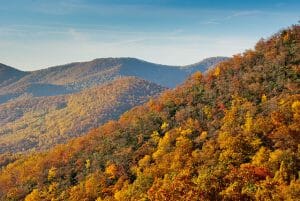Deciduous Forest Facts
The two main types of deciduous forests on Earth are temperate deciduous forests and tropical/subtropical deciduous forests. Here are 10 key facts about each of them.
Temperate Deciduous Forest Facts
- Some common trees found in these forests are maple, beech and oak.
- Temperate forests are those in regions that are neither too hot or too cold.
- The largest temperate deciduous forest is in the eastern part of North America, which was almost completely deforested by 1850 for agricultural purposes.
- Temperate deciduous forests are organized into 5 zones based on the height of the trees. From tallest to shortest they are the tree stratum zone, the small tree and sapling zone, the shrub zone, the herb zone and the ground zone.
- The coldest temperatures in temperate deciduous forests range from about 37°F to 64°F.
- Deciduous trees in these forests drop their leaves in fall and regrow them in spring.
- The trees in temperate deciduous forests are angiosperms, meaning they have flowers and produce seeds.
- Besides the eastern part of North America, the other largest areas of temperate deciduous forest are in Europe, East Asia, the Near East and South America.
- Aside from farming, fungal diseases currently pose the greatest threat to these forests, and humans are almost always the cause of their introduction and transmission in an area.
- The color change of the leaves on deciduous trees in fall is due to the death of chlorophyll, the pigment that makes the leaves green. The leaves show their true colors once the masking of the green color is removed.

The image above shows the autumn color change in a temperate deciduous forest near Ashville, North Carolina.
Tropical/Subtropical Deciduous Forest Facts
- Tropical/subtropical deciduous forests can be dry broadleaf forests or wet broadleaf forests. The dry broadleaf forests tend to be in the drier climates that lie to the north and south of the wet broadleaf forests.
- The leaves on the trees in tropical/subtropical deciduous forests fall in the dry season and regrow in the rainy season. Dropping leaves in the dry season helps the trees conserve water.
- These types of forests stay warm year-round and can receive several hundred centimeters of rain every year.
- Wet broadleaf forests tend to have more evergreen and fewer deciduous trees than dry broadleaf forests.
- Tropical and subtropical moist broadleaf forests are sometimes called jungles or rainforests, although these are two different biomes. Rainforests have tall trees that create a thick canopy that makes it hard for light to penetrate to the forest floor. The jungle surrounds the rainforest and is home to a dense growth of vegetation and plants. Jungle areas receive more sunlight because of the lack of tall trees.
- Dry broadleaf forests are found around equatorial Africa, India, Southeast Asia, South America, Central America, Australasia and the tropical islands in the Pacific Ocean.
- Wet broadleaf forests are in the Amazon basin of South America, the Congo basin of central Africa, the Caribbean, Indochina and the Malay Archipelago.
- Tropical/subtropical deciduous forests are home to plants such as woody vines, orchids and teak and bamboo trees.
- Dry broadleaf forests are very sensitive to burning, deforestation and overgrazing.
- The most plant and animal diversity in dry broadleaf forests is found in southern Mexico and the lowlands of Bolivia in central South America.

The image above shows the Ulva Island rainforest located near New Zealand.
References
- Deciduous Forests. (n.d.). In Encyclopedia.com Online. Retrieved October 4, 2017, from http://www.encyclopedia.com/plants-and-animals/botany/botany-general/deciduous-forests
- Tropical and Subtropical Dry Broadleaf Forests (n.d.). In Wikipedia. Retrieved October 4, 2017, from https://en.wikipedia.org/wiki/Tropical_and_subtropical_dry_broadleaf_forests
